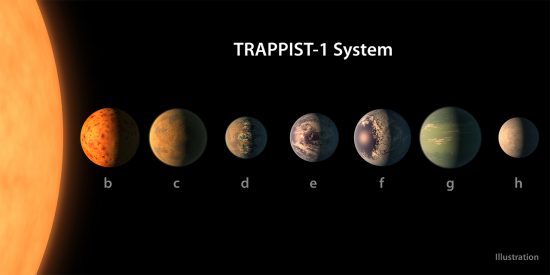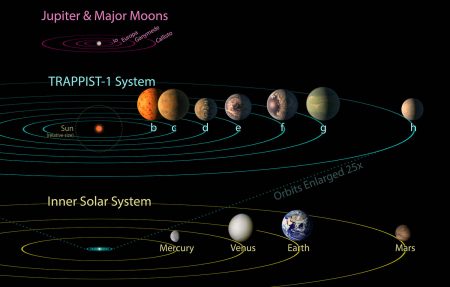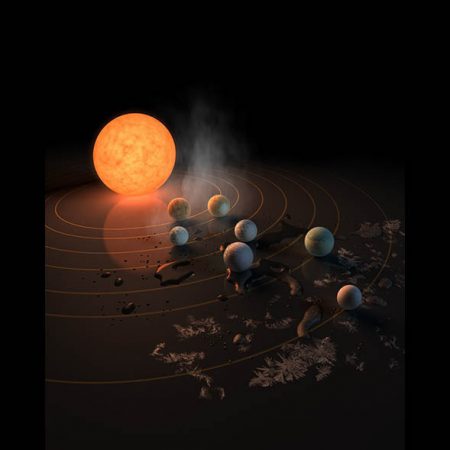February 23, 2017 – This morning I spotted my first Robin of the season, almost a month ahead of the formal date we celebrate as spring. I had heard Robin birdsong the last couple of days when walking my dog, Maya, but finally found one of the birds announcing his presence from high in a tree. That’s not all. Nearby I spotted a Cedar Waxwing trilling away and being answered by others further away. This annual renewal in the cycle of the planet always brightens my day.
But yesterday NASA appealed to our imaginations with an announcement that was given considerable fanfare in the run-up to it for several days. If I didn’t write about this discovery, I am sure, some of you would have wondered how I missed it considering how many postings appear here about space discoveries. But this media buzz that preceded the announcement was not typically NASA. The last one I remember like this concerned a discovery made by Curiosity back in 2012 that NASA scientists called “one for the history books.” That was about organic matter found in samples collected by the Martian rover.
So when NASA let everyone know it was holding a press conference on Thursday I speculated on what the announcement would be. I thought, did they discover oxygen in the atmosphere of an exoplanet? Or did Curiosity find more evidence of past life on Mars? Well, it was none of the above. It was about exoplanets but this time it was the revelation of a remote solar system associated with a red dwarf star. Now finding alien solar systems is nothing new. Exoplanet hunters have been discovering alien solar systems from the first exoplanet announcements. The current total stands at 2,688 with 603 having more than two planets orbiting a distant star. The current number of discovered exoplanets stands now at 3,583. Among that number are the 7 newly announced yesterday.
Now finding alien solar systems is nothing new. Exoplanet hunters have been discovering alien solar systems from the first exoplanet announcements. The current total stands at 2,688 with 603 having more than two planets orbiting a distant star. The current number of discovered exoplanets stands now at 3,583. Among that number are the 7 newly announced yesterday.
So what made NASA call in the world press about this latest discovery?
The 7 planets discovered are described as Earth-sized in the NASA press release. Earth-sized is nothing new. We’ve been finding many rocky exoplanets of late as we apply more sophisticated exoplanet discovery techniques that allow us to determine not only location, but size and specific gravity. But finding 7 all in the same solar system, with three in the Goldilocks Zone (where liquid water can occur on the planet’s surface) represents something never seen before. Compare that to our Solar System where we have 2 Earth-sized planets circling the Sun, Venus, and Earth. A third, Mars, barely Earth-sized, sits at the far edge of our Sun’s Goldilocks Zone making it barely inhabitable. Venus, on the other hand, is victim to a runaway greenhouse effect, turning the planet into an environment equivalent to our representations of hell.
But this new solar system, circling a star designated Trappist-1, a cool red dwarf, is the first to have so many planets similar to Earth in size, and so many situated within the definition of habitable. In fact, the NASA scientists told the press assembled and listening, that all 7 planets could have liquid water on their surfaces if atmospheres were present. Stated Thomas Zurbuchen, Associate Administrator, NASA Science Mission Directorate, “this discovery could be a significant piece in the puzzle of finding habitable environments, places that are conducive to life.”
Trappist-1 is 40 light-years from Earth. It is named for the Chilean telescope that first observed the exoplanets orbiting around it. Several other ground-based telescopes and the Spitzer space telescope confirmed the discovery shortly thereafter. Last Wednesday the results were published in the journal Nature. The article was entitled “Earth’s seven sisters.”

The Spitzer telescope was able to measure the precise size of each of the 7, developed estimates of their mass and density. The observations suggested all were rocky planets like Earth. From the innermost to the seventh, the Trappist-1 solar system appears to be far different from the one in which we reside. Trappist-1 is relatively cool when compared to the Sun. That means planets even in close proximity to it could be habitable. In fact, all 7 are closer to their star than Mercury is to our Sun (see illustration comparing the two solar systems below).

All 7 of Trappist-1’s planets are much closer to each other than those in our Solar System. Whatever life may inhabit one or more of them would, upon gazing into the night sky, see an endless array of objects about the size of our Moon as seen from Earth casting reflected light. If these planets had atmospheres and oceans the observer would see clouds and Trappist-1 starlight glittering off the water surfaces.
NASA scientists speculate that some of the planets may be tidally locked. The term tidally locked describes the phenomenon we observe with our own Moon. We always see the same Moon surface, never the opposite, which we call the dark side even though for every lunar cycle it is as equally lit as the side that presents itself to us. If some or all of Trappist-1’s planets are tidally locked, then one side will be in perpetual darkness, lit only by reflected light from its neighbours and starlight.
What has made the NASA announcement so inviting, that every newspaper and media outlet around the world, from Delhi to Moscow to Toronto, has put it on or near the front page of today’s papers, or made it a leading story in nightly newscasts?
Sean Carey, Manager of the Spitzer Science Center, Caltech/IPAC, thinks “this is the most exciting result I have seen in the 14 years of Spitzer operations.” There’s no doubt the discovery of an alien solar system with 7 rocky planets, 3 potentially habitable, is newsworthy. But for as much as we have discerned from Spitzer and Earth-based telescope observations, we still don’t know very much about the Trappist-1 solar system. So NASA is now creating time on the Hubble Space Telescope to do a closer examination. Initial Hubble observations indicate no evidence of any significant atmosphere on the innermost two exoplanets. Well that’s a bummer. But NASA spokespersons state that when the James Webb Space Telescope is launched in 2018, it too will turn its attention to Trappist-1 to learn more.

Postscript: If you are wondering how an Earth-based telescope could discover an alien solar system, the answer is, by observing, from our frame of reference, small changes in starlight over time. These perturbations in the amount of observed light indicate the presence of objects circling the star. Understand that this only works when an alien solar system’s plane approximates that of ours here in the Solar System so we can see these planetary crossings edge on. For the vast majority of alien solar systems yet to be discovered, we need different technology that sees exoplanets and alien solar systems on very different planes. When you consider we have found close to 2,700 already which are edge on to our point of view, imagine how many more there are in the Milky Way that, as of yet, we cannot see.







